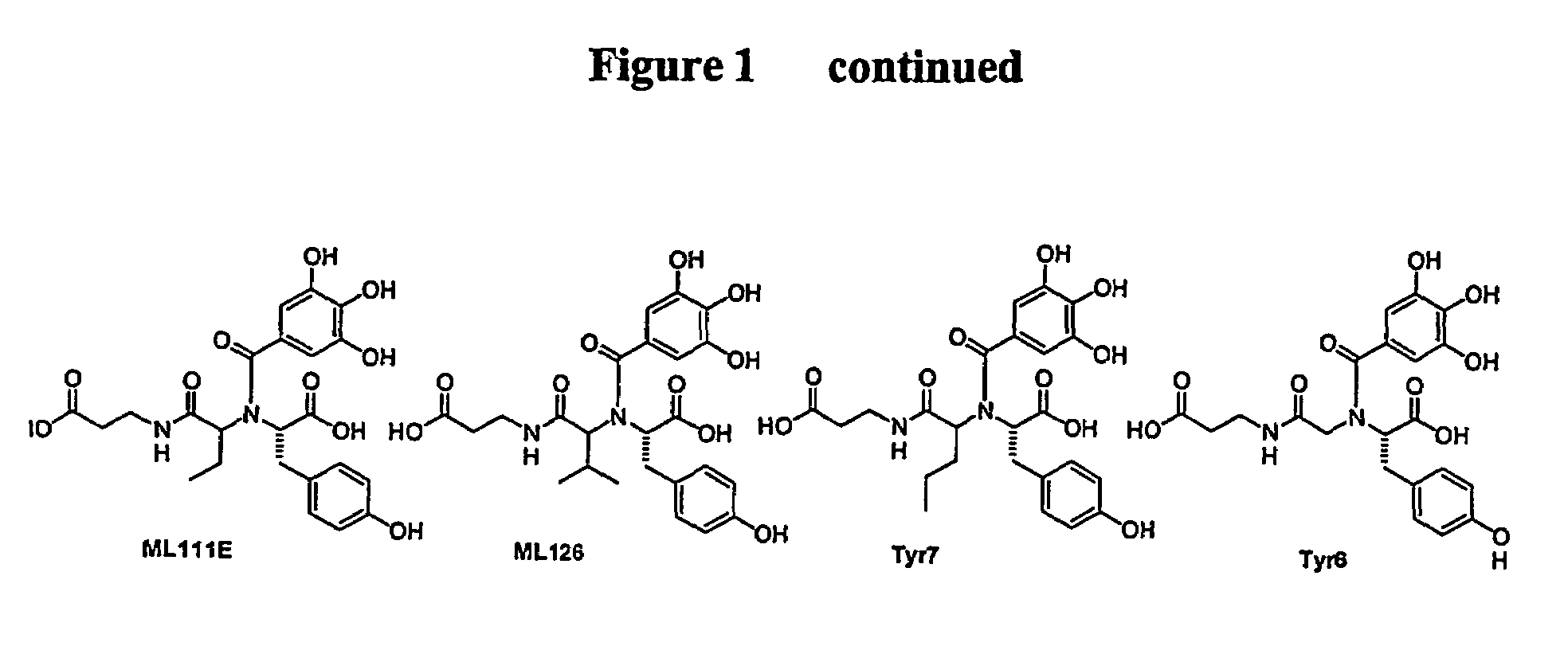Polyhydroxy phenols and their use in binding p-selectin
a polyhydroxy phenol and phenol technology, applied in the field of polyhydroxy phenols, can solve the problems of difficult to attribute a reduction of atherosclerosis process, higher risk of recurrent coronary artery disease, and major cause of death of cad in western societies, and achieve the effect of large interindividual variability
- Summary
- Abstract
- Description
- Claims
- Application Information
AI Technical Summary
Benefits of technology
Problems solved by technology
Method used
Image
Examples
example 1
3,4,5-tri-O-(tert-butoxycarbonyl)-gallic acid
[0105]To gallic acid (5.0 g, 29.4 mmol) was added anhydrous DCM (60 mL). Nitrogen gas was bubbled through the inhomogeneous mixture for 5 minutes. Then, the mixture was treated subsequently with pyridine (88.2 mmol, 7.1 mL), di-tert-butyl dicarbonate (88.2 mmol, 19.2 g) and 4-dimethylaminopyridine (0.3 mmol, 37 mg). Gas evolution was observed and after 1 hour the mixture became homogeneous. After 2 hours, TLC analysis (eluent: ethyl acetate) revealed completion of the reaction. The reaction mixture was diluted with DCM (200 mL) and washed with 1 M HCl and water. The organic phase was dried on MgSO4, then filtered and concentrated in vacuo. The residue was applied to a silica gel column and eluted with 10% ethyl acetate in toluene. Collection of the appropriate fractions afforded the title compound (9.26 g, 19.7 mmol, 67%) as a white solid.
[0106]13C-NMR (50 MHz, CDCl3) δ 169.9, 149.9, 148.6, 143.8, 139.7, 126.9, 122.2, 84.6, 84.5, 22.4; 1H...
reference example 2
Synthesis of the Nitrites with Acid-Labile Protection
[0107]Tert-butyl isocyanoacetate was synthesised according to literature precedent: B. H. Novak and T. D. Lash, J. Org. Chem. 1998, 63, 3998-4010.
[0108]Tert-butyl isocyanopropionate was synthesised in two steps from commercially available β-alanine tert-butyl ester hydrochloride (NovaBiochem) as follows. To a solution of β-alanine tert-butyl ester hydrochloride (2 g, 11 mmol) in tetrahydrofuran (5 mL) and ethyl formate (5 mL) was added triethylamine (12 mmol, 1.7 mL). The flask was fitted with a reflux condenser and the mixture was heated for 4 hours, after which another quantity of ethyl formate was added (1 mL). An hour later, the mixture was filtered over silica gel. The silica gel was washed with ethyl acetate. The volatiles were removed from the filtrate, yielding N-formyl β-alanine tert-butyl ester (1.4 g, 11 mmol). 13C-NMR (50 MHz, CDCl3) δ 171.2, 163.4, 80.8, 34.7, 33.4, 22.7; 1H-NMR (200 MHz, CDCl3, TMS) δ 8.15 (s, 1H), 6...
example 3
Experimental Procedure for Ugi Reaction
[0110]The Fmoc-protected amino acid was coupled to Tentagel resin equipped with the hydroxymethyl-phenoxyacetic acid (HMPA) linker via the standard procedure (DIC / DMAP in DCM / NMP). The loading of resin 1 was established via standard Fmoc-determination (typically 0.16 to 0.22 mmol / g).
[0111]All Ugi reactions were carried out on a 10 μmol scale. The Fmoc group on the amino group of 1 was removed by treatment with 20% piperidine in DMF for 15 minutes. After rinsing the resin with NMP (2×) and DCM (2×), aldehyde 2 (100 μmol) and anhydrous DCM (0.2 mL) were added. The resin was agitated for 1 hour. Then, a solution of tri-Boc-gallic acid (1, 100 μmol, 47 mg) in anhydrous MeOH (0.2 mL) and nitrile 4 (100 μmol) were added to the mixture. Shaking of the resin was continued for another 15 hours. The resin was then filtered, washed with NMP, MeOH and DCM (2× each). Cleavage from the solid support and deprotection of the product was attained by treatment o...
PUM
| Property | Measurement | Unit |
|---|---|---|
| pH | aaaaa | aaaaa |
| flow rate | aaaaa | aaaaa |
| pH | aaaaa | aaaaa |
Abstract
Description
Claims
Application Information
 Login to View More
Login to View More - R&D
- Intellectual Property
- Life Sciences
- Materials
- Tech Scout
- Unparalleled Data Quality
- Higher Quality Content
- 60% Fewer Hallucinations
Browse by: Latest US Patents, China's latest patents, Technical Efficacy Thesaurus, Application Domain, Technology Topic, Popular Technical Reports.
© 2025 PatSnap. All rights reserved.Legal|Privacy policy|Modern Slavery Act Transparency Statement|Sitemap|About US| Contact US: help@patsnap.com



